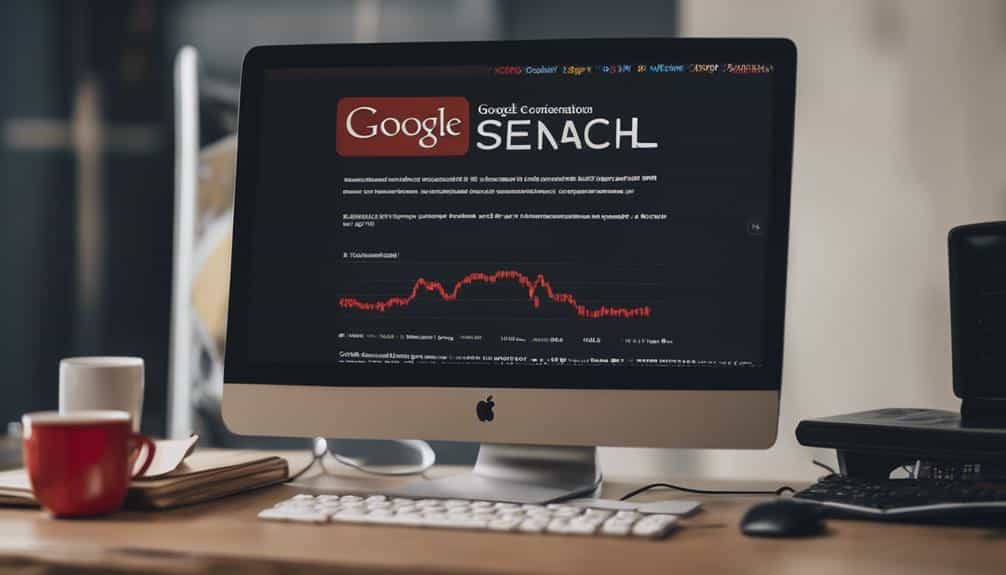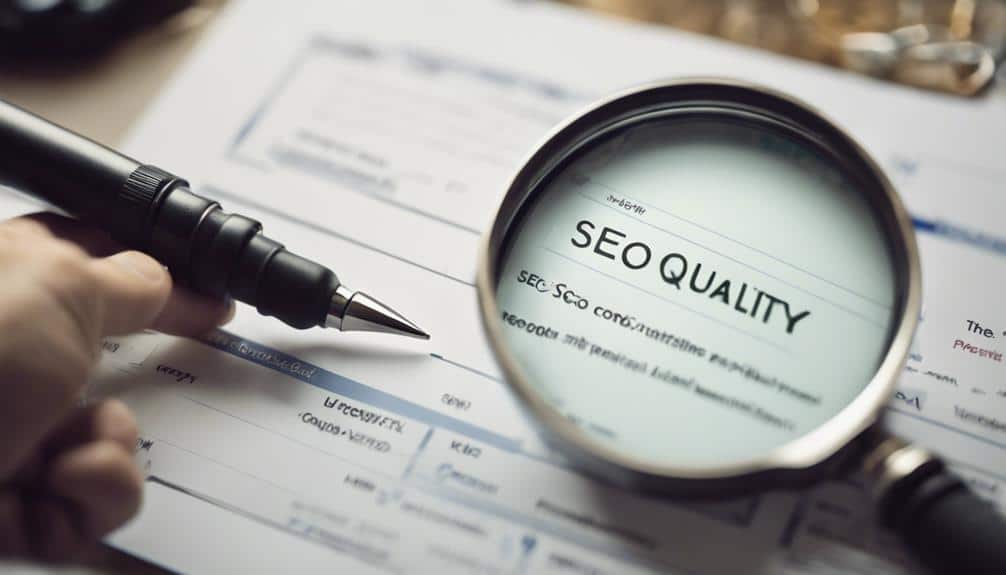Recovering from a Google penalty involves correcting violations such as unnatural links or thin content, enhancing overall site quality, and adhering to Google's guidelines. It's essential to submit reconsideration requests for manual penalties and monitor performance metrics closely to avoid future penalties. Understanding the distinction between manual and algorithmic penalties, addressing issues with the link profile, and staying informed about industry updates are vital steps in the recovery process. To gain further insights on effective strategies and best practices for Google penalty recovery, exploring in-depth guidance and case studies can provide valuable assistance.
Key Takeaways
- Rectify violations and enhance site quality post-penalty.
- Conduct backlink analysis and SEO audit for improvements.
- Submit reconsideration requests for manual penalties through Search Console.
- Monitor for future penalties by staying informed and vigilant.
- Clean up backlink profile to avoid future penalties and maintain integrity.
Recognizing Google Penalties

Recognizing Google penalties involves understanding the distinction between essential and algorithmic penalties, each imposed for specific violations that impact a website's search visibility and ranking. Manual penalties are enforced by Google employees for infringements such as unnatural links or spammy content. These penalties can be observed in Google Search Console under Manual Actions, providing website owners with insights into the exact violations causing the penalty. On the other hand, algorithmic penalties are activated by Google algorithms like Panda and Penguin, influencing search rankings based on various criteria. Recovering from Google penalties requires identifying the issue, implementing corrective measures, and submitting a reconsideration request for manual penalties. Common triggers for Google penalties encompass practices like keyword stuffing, hidden links, thin content, and low-quality backlinks, all of which can lead to SEO and visibility challenges if not addressed promptly and effectively. Understanding the nature of these penalties is vital for website owners to navigate the complexities of search engine optimization and maintain a favorable online presence.
Addressing Penalty Issues
To effectively address penalty issues on a website, proactive steps must be taken to rectify violations and enhance overall site quality. When dealing with a Google penalty, whether manual or algorithmic, it is important to conduct a thorough backlink analysis using tools like Google Search Console and the disavow tool to identify and remove spammy or low-quality links that contravene Google's guidelines. Additionally, performing an SEO audit to improve content quality is vital. This involves removing thin or duplicate content, focusing on relevance and value, and ensuring a positive user experience. Adhering to Google's guidelines for content quality and relevance is key to avoiding future penalties. Building high-quality backlinks through ethical practices can also help boost site authority and credibility, further aiding in penalty recovery efforts. By following these steps diligently, a website can address penalty issues effectively and work towards regaining its ranking and visibility on search engine results pages.
Submitting Reconsideration Requests

Following the necessary steps to address Google penalties, the process of submitting reconsideration requests is a crucial aspect of the recovery strategy for websites facing manual penalties. Reconsideration requests for manual penalties are submitted through Google Search Console, detailing the actions taken to rectify the issues that led to the penalty. On the other hand, for algorithmic penalties, website owners need to wait for Google to re-crawl and re-index the site after implementing necessary fixes. The recovery time post-reconsideration can vary greatly, ranging from a few days to several months, depending on the severity of the penalty and the effectiveness of the actions taken. It is essential to understand the distinction between manual and algorithmic penalties to devise an effective Google penalty recovery plan tailored to the specific circumstances of the website, including addressing issues with the link profile such as unnatural links that may have triggered the penalty and impacted the Google ranking.
Monitoring for Future Penalties
After addressing Google penalties through reconsideration requests, the focus shifts to vigilantly monitoring for future penalties to safeguard the website's performance and ranking integrity. Regular monitoring of Google Search Console for penalty notifications is essential. Alongside this, keeping a close eye on website performance metrics and traffic patterns can help detect any sudden drops that may indicate a penalty. Staying informed about industry updates and changes in the Google algorithm is vital to proactively prevent penalties. Conducting regular SEO audits is also key to identifying and addressing any potential issues that could lead to penalties. It is imperative to engage in ethical SEO practices to maintain a clean and compliant website that adheres to Google's guidelines. By implementing these monitoring strategies and staying proactive, website owners can reduce the risk of incurring Google penalties and secure the longevity of their online presence.
Identifying Manual Penalties

When exploring the domain of Google penalties, an essential step is the ability to accurately identify manual penalties imposed by Google employees for various violations. Manual penalties are specific actions taken against a website for breaching Google's Webmaster Guidelines, such as having unnatural links or spammy content. These penalties can be observed in the Google Search Console under Manual Actions. Site owners who receive manual penalties are required to take corrective actions to address the issues that led to the penalty and then submit a reconsideration request to Google. Examples of manual penalties include thin content, which lacks substance or value for users, as well as unnatural links and keyword stuffing. By promptly identifying manual penalties and taking the necessary steps to rectify the violations, website owners can work towards recovering their site's visibility and ranking on Google.
Understanding Algorithmic Penalties
An in-depth understanding of algorithmic penalties is essential for website owners aiming to navigate the complexities of Google's search quality guidelines. Algorithmic penalties are automated actions taken by Google's algorithms against websites that violate search quality guidelines. These penalties are not imposed by manual review but are triggered by algorithm updates such as Panda, Penguin, or core updates. Common triggers for algorithmic penalties include thin content, keyword stuffing, low-quality backlinks, and other violations of Google's guidelines. Recovering from algorithmic penalties can be a lengthy process, sometimes taking up to six months, as websites need to make significant changes to regain search visibility. To effectively recover from algorithmic penalties, it is important to monitor algorithm changes, conduct regular SEO audits, and focus on improving site quality to align with Google's quality guidelines. Website owners must stay informed about the latest algorithm updates to guarantee compliance and maintain search visibility.
Examining Ranking Issues

Upon encountering ranking issues, website owners must diligently examine various factors that could potentially impact their site's performance in search engine results. Checking Google Analytics for traffic drops and changes in user behavior can provide insights into potential ranking issues. Additionally, reviewing Search Console for manual actions or notifications about penalties is pivotal in understanding how they may be affecting SERP positions. Examining recent algorithm updates is also vital to determine if any changes have influenced the site's rankings.
Moreover, it is important to look for technical issues such as site speed, mobile-friendliness, or indexing problems that could be hindering the site's performance in search results. Analyzing keyword performance and SERP positions can help identify specific areas where improvements are needed to enhance ranking issues. By addressing these factors systematically, website owners can work towards resolving any issues impacting their site's visibility and search engine rankings.
Analyzing Algorithm Updates
Analyzing recent algorithm updates is vital for website owners looking to adapt their SEO strategies and maintain or improve their search engine rankings. Google's algorithm updates, such as Panda and Penguin, play an important role in determining a website's visibility and ranking. These updates target sites with low-quality content, spammy backlinks, and other violations to enhance search result quality. Webmasters must stay informed about these changes, understand Google's best practices, and promptly address any issues to recover from algorithmic penalties. By comprehending the criteria and implications of algorithm updates, website owners can uphold a strong online presence and steer clear of penalties. Keeping abreast of Google's evolving algorithms and making necessary adjustments can aid websites in compliance and bolstering their search engine rankings. It is imperative for webmasters to continuously monitor and analyze algorithm updates to align their SEO strategies with the latest requirements and maintain sustained online visibility.
Conducting SEO Audit

To guarantee website health and compliance with Google's guidelines, website owners must prioritize conducting thorough SEO audits. An SEO audit involves a detailed review of website performance, content quality, and backlink profile. By evaluating these areas, potential issues such as thin content, duplicate content, and bad backlinks that could lead to Google penalties can be identified and addressed promptly. Utilizing tools like Google Analytics, Google Search Console, and specialized SEO audit tools can streamline the audit process and provide valuable insights.
It is essential for SEO audits to focus on technical SEO aspects, on-page SEO factors, and user experience to make sure that the website aligns with Google's guidelines. Regular audits every 6-12 months are vital for maintaining website health and avoiding potential penalties. By conducting these audits proactively, website owners can stay ahead of issues, optimize their online presence, and enhance their overall performance in search engine rankings.
Cleaning Up Backlink Profile
Strategically managing and refining a website's backlink profile is a fundamental step in the process of Google Penalty Recovery. Identifying toxic backlinks using tools like Google Search Console and Moz is essential. Removing these harmful backlinks not only helps in improving site credibility but also enhances SEO performance. Utilizing Google's Disavow Tool to disavow bad backlinks is vital for cleaning up the backlink profile effectively.
Regular monitoring of the backlink quality is necessary to guarantee a healthy link profile post-recovery. Emphasizing quality over quantity in link building is key to avoiding future penalties and maintaining site integrity. By focusing on acquiring high-quality backlinks from authoritative sources, websites can safeguard themselves against potential penalties and algorithm updates. Therefore, a meticulous approach to cleaning up the backlink profile is paramount for successful Google Penalty Recovery.
Frequently Asked Questions
How Do I Remove a Google Penalty?
To remove a Google penalty, one must identify the penalty type, rectify underlying issues like spammy backlinks or thin content, submit a detailed reconsideration request to Google, and await re-crawling and re-indexing to evaluate compliance with guidelines.
How Long Does Google Penalty Last?
The duration of a Google penalty varies depending on factors like the penalty type, severity, and cleanup efforts. Manual penalties typically lift in 10-30 days, while algorithmic penalties like Panda or Penguin may take over 6 months to recover from.
How Do I Check My Google Penalties?
To check for Google penalties, monitor Google Search Console for manual actions, observe traffic and ranking changes for algorithmic penalties, review notifications, assess backlink profiles for harmful links, and guarantee compliance with Webmaster Guidelines to prevent penalties.
How Do I Recover My SEO Penalty?
To recover from an SEO penalty, identify the root causes like unnatural links or thin content, clean up backlink profiles, optimize on-page elements, and submit a reconsideration request to Google. Patience is key during the evaluation process.
